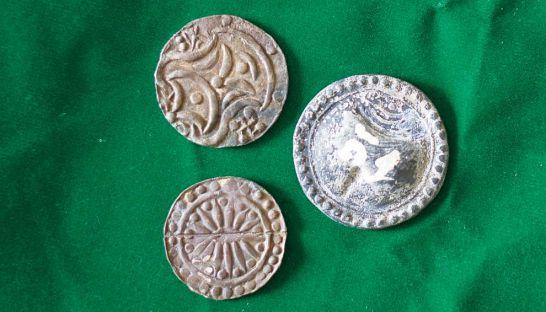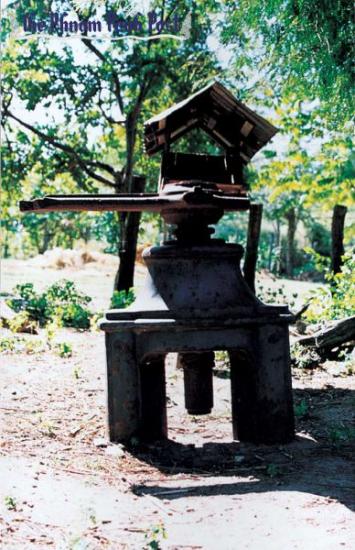Moeun Nhean
Source - http://www.phnompenhpost.com/special-reports/cambodias-monetary-history
 Copper and silver coins found at Angkor Borey can be seen up close. They date back to the 4th or 5th century. Moeun Nhean
Copper and silver coins found at Angkor Borey can be seen up close. They date back to the 4th or 5th century. Moeun Nhean
On viewing the ancient Khmer temples that lay across the Indochina peninsula, it is impossible not to praise the talent of the civilisation that built them. The Khmer nation’s economy during this era is just one of the many mysteries behind the wonderful temples. Did the ancient culture have monetary notes in circulation for selling, buying or trading goods?
Archaeologists have indeed found forms of monetary notes made of multi-metal, silver and gold. Dating back across several eras, the coins are now kept at the archaeology station in Angkor Borey, Takeo province, and many other archaeology stations in Cambodia and Thailand. They provide evidence of the progress of ancient Khmer trade, showing that the society created its own currency in order to ease trading activities and daily living, and make payments for domestic and international trade.
Dr Michael Trané, a specialist in Khmer culture and civilisation and former under-secretary at the Ministry of Culture and Fine Arts, has written a book titled History of Khmer Money. He says that “a lot of evidence has been found, such as copper notes, mirrors, Buddhist statues, and ceramics. The study of these ancient objects has informed people about the prosperity and progress of Cambodia’s ancient era, which resulted from a regime of monarchy and trade, and made people prosperous and wealthy.”
Over recent years, Trané has been finishing his new book Funan Currency, which is due to be published soon. In an exclusive interview with The Phnom Penh Post, he presented evidence of the prosperous history and culture of the Khmer nation in the Nokor Phnom era, known by the Chinese as the Funan era. This empire, which existed from the first to sixth century CE, had currency in circulation which was used to trade with businessmen from countries such as India, Malaysia, Iran, even Greece and the Roman Empire.
Trané confirms that “ancient Khmer people developed religion and trade from India. The creation of its currency also seems to have developed from India, which was in turn influenced by the Greek and Roman empires, which used to occupy Indian territory in the prehistoric era.” Judging from the evidence of coins from the Khmer Nokor Phnom time, most of the people living in the coastal plains were wealthy from agricultural work, fishing and sea trade.
Sam Bath, an officer at the Department of Culture and Fine Arts of Takeo province, says that currently there are many examples of metal money in the Takeo museum gallery from the Nokor Phnom era, the post-Angkor era, the Oudong era and the Chaktomuk Phnom Penh era.
 Today, only one coin making machine has survived. Moeun Nhean
Today, only one coin making machine has survived. Moeun Nhean
Nokor Phnom monetary notes
Monetary notes issued for use in the Nokor Phnom era can be seen at the Angor Borey archaeology station in Takeo province, as well as the O’Keo archaeology station. These currencies are in the form of round coins made of metal, bronze, silver, and even gold. Nokor Phnom-era monetary notes have a diameter of about 20 to 34 millimetres, are two to three millimetres thick and weigh between eight to ten grams. Their surface features decorations depicting snails, suns, moons and portraits of Lakshmi, the wife of Lord Vishnu.
Trané explains that “it was not by chance that our ancestors in the Nokor Phnom era were able to create their own monetary notes. Firstly, it showed their wealthy status. Secondly, it was a means for trading both domestically and overseas. Thirdly, it demonstrated their country’s power; and fourthly it represented progress in both Hindu and Buddhist beliefs and prosperity for the nation.”
“The ability to create monetary notes contributed to the global maritime trade sector of that era,” Trané adds. “It clearly reflected the evolution of Nokor Phnom, which transferred from family economy to community economy and then to social economy, eventually building up to global economy through maritime trade with other empires such as those of India and China, which emerged in the middle of the Nokor Phnom era.”
Trané elaborates that “coins ranged from round coins, half round coins, one-quarter coins, one-fifth coins, up to a one-sixth coin. The round coin may have been able to buy a cow, while the half round coin could buy a pig or something smaller.”
At the time, Nokor Phnom played a role as an intermediary between two empires: India and China. The O’Keo port of the Nokor Phnom Empire seemed to be the focal point for trading with businessmen from southern India, as well as businessmen from eastern and southern China.
Prak Born is the director of the Culture and Fine Arts Department in Takeo province, which was the base of the civilised Nokor Phnom Empire until it evolved into the Kingdom of Cambodia as we know it today. He says that “the end of the Sovannaphoumi peninsular in the Indochina mainland is the middle point between east and southern Asia. It was a favourable place for businessmen from the Chinese and Indian continents, as well as from the Middle East, to make appointments for trading.”
“The trading at the O’Keo port included the goods of the Nokor Phnom Khmer people, as well as goods from abroad. It is thought that the Nokor Phnom State spanned from the Sovannaphoumi peninsular or the regional Mekong delta which had a lot of natural resources. The ancient people were in need of the products of Nokor Phnom people,” says Born. “There is evidence that the value of the Nokor Phnom Empire’s money had a global reach, and probably remains valuable today as it was made from metals such as bronze, silver and gold.”
“In the Phnom Da area of Angkor Borey district in Takeo province – formally part of the Nokor Phnom Empire – we found many types of round coins which were tested by Russian scientists who claimed that they date from the 4th to the 5th century. A lot of gold coins were also found. In Angkor Borey, people still sieve for them along the bank of Borey tributary, finding them frequently even today.
“The Nokor Phnom Empire, which existed since the beginning of the history until the 6th century, depended on the factors of geography, human resources and economic resources,” says Born. “In fact, great civilisations all primarily depended on the power and strength of their economic resources.”
 The French colonial government was the first to introduce paper money to Cambodia during the 19th century. Moeun Nhean
The French colonial government was the first to introduce paper money to Cambodia during the 19th century. Moeun Nhean
Money in the Chenla era
According to His Excellency Chuch Phoeun, secretary of state from the Ministry of Culture and Fine Arts, Cambodians have only just discovered a gold coin, which dates to the Chenla era between the 6th to 7th century. The gold coin is kept by the National Bank of Cambodia, and will be displayed to the public soon after the launch of the ‘Currency and Economic Museum’ museum at the Wat Phnom pagoda. “We believe that many of the ancient Khmer currencies still exist in most of the former cities of ancient Cambodia, and we hope we will find more,” he says.
If we look from the prehistoric era to the present time, Khmer society has always been able to convert their crops into other goods. Phoeun claims that “the tradition of exchanging and trading played a major role in family economy, community economy, national economy and overseas trading”.
Phoeun explains that “in the daily lives of the Khmer people from ancient times, they exchanged products with each other,” such as swapping their rice, corn, and beans with fish, cows, buffalo, or even farmland and houses. “Besides the exchange of products, there was also an exchange between products and labour force,” he says.
Monetary notes in the Angkor and post-Angkor era
Ros Chantrabot’s book King’s Kan describes the history of Sdech Kan, or King Kan. The book delves into the reign of King Kan, who produced many types of money for his people, such as the Sleung currency and the Snok currency.
Coins were in continual use by Khmer people until the era of King Ang Duong, the king who led the Kingdom between 1848 and 1860 before the French colonialists arrived in the mid-1860s. During the early days of French colonial times, Cambodian people still used their own coin currency, until the French developed and printed paper currency for Cambodia, Laos and Vietnam.
It took nearly one century until modern Cambodians had a chance to recreate an independent national currency. Since King Sihanouk achieved full independence from the French in 1953, the National Bank of Cambodia has been the head of national currency operations.
Today, only one money-making mold was lucky enough to survive its own era in good condition, while the others have since fragmented and disappeared. This surviving ancient mold was established in the reign of King Ang Duong between 1848 and 1860, when the capital of Cambodia was located in Oudong. The mold was found in Khlaing Pram village in Kampong Speu province. Today, the local villagers revere the mold as a patron spirit, and call it Lok Ta Poum Prak, or the coin mold spirit.